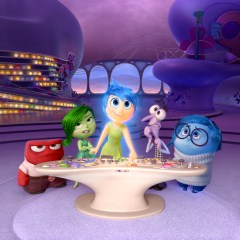By Ed Sum (The Vintage Tempest)

When I have a buddy whose first impression of what PIXAR’s Inside Out is about is that of copying the comedy from Herman’s Head, I had the desire to knock some sense into his brain. The analogies are completely different and how can one not love any movie made by this studio? Did he not know that this story was directed by Pete Docter, the same person who created the much-loved Up!? When considering I did not think highly of Monsters University or Cars 2, there might be a reason to not enjoy this film since this studio’s track record has not always surpassed previous products. In between these two films, I found more to love about Brave with its Celtic supernatural themes.
I have a fondness for PIXAR properties that feature strong female characters. To see what’s going on in the mind of Riley (voiced by Kaitlyn Dias) in her tween years certainly makes for some amusing fun as she learns how to ride that emotional roller coaster of life. The Traveling Wilburys’ song of the same name comes to mind after seeing this film. When her life gets relocated to San Francisco because her father has been offered a new job (they’re originally from Minneapolis), just how anyone feels after such a drastic change really has to be explored. To have the story focus on what’s going on in Riley’s head is amusing. It’s rich with vibrant characters and colours representing her five core moods. Because certain aspects of her emotional psyche are in conflict over what represents the greater whole, the sub-personas Joy (Amy Poehler) the Pixie or Sadness (Phyllis Smith) the muppet show that without either of them, the person that they represent can and did have a melt-down. Riley misses everything from her life back in Minnesota.

Writers Pete Docter and Ronnie del Carmen certainly had a tough time boiling down the list of 23 possible emotions down to five. And for those audiences who went to the early screening of this film were treated to a taped Q&A (it was only broadcasted live on the East Coast of North America) that answered a few tough questions. Hopefully this video will be offered when the movie releases to disc because it offers some great answers to nagging questions as to how to keep the story simple without going Sigmund Freud or Carl Jung on the subject of child psychology.
The work done is magnificent! The tale does not pander and serves to explain how conflicting emotions can work together to bring a balance to anyone’s life. Memories are just as important, and to create abstractions as to how the brain works in a cartoon universe is one that will make this movie quite memorable in the years to come. The charm with this film is in how it explains how people respond to memories through emotions. They are not necessarily limited to one feeling.
Any set of emotions can work to create a marble like structure, like yin and yang, but that Buddhist philosophy is not going to be known by everyone. To see how these two psyche’s (Joy and Sadness) get into conflict with one another because they do not understand what they fully represent defines most of this film’s narrative. To witness how Riley reacts when two of the five go missing (they all live in a brain-like hub) can bring about some interesting analogies as to how some people shut down when life becomes overwhelming. In this young girl’s case, it’s in not just being transplanted to a new city but also in learning how to express herself. Most children live with a lot of joy in their lives. The islands (Family, Friendship, Hockey, Honesty and Goofball) that are formed in her mind are great metaphors of what aspects of her life she treasures the most. They house specific memories that honours what she values as important aspects of herself.

The colour palette that’s used in this film is not just limited to how the emotions are painted up. To see how Riley dresses is just as important; when all she wears is grey, that means she’s turned into a void. Although Anger (Lewis Black), Fear (Bill Hader) and Disgust (Mindy Kaling) are left manning the ship, they soon realize that without the others, just what Riley grows up to can become emo unless Joy and Sadness return.
A lot of thought is put into developing this movie. It’s not just a simple comedy. This film is a drama that praises the virtue of how to work together to overcome problems. Much like Toy Story‘s “You’ve Got a Friend in Me,” this movie preaches the same idea because it’s possible to stick together and see any problems faced through life.
Everyone has complex emotions that are defined by which part of the psyche is the dominant one and if I had to guess at what drives one of my friends, I would have to say fear of seeing a rehash of an old television program is what drove him to initially reject Inside Out. At least he’s turned around when new trailers emerged to define what this movie is about: to celebrate the fact we are all complex individuals who are always lost in thought. Those little voices we hear serve to protect us in ways we just don’t realize.
4 Stars out of 5

